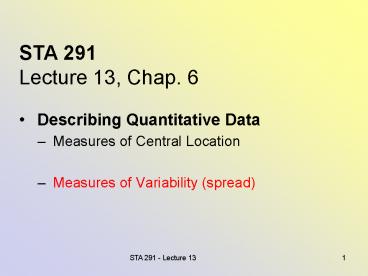Describing Quantitative Data - PowerPoint PPT Presentation
Title:
Describing Quantitative Data
Description:
STA 291 Lecture 13, Chap. 6 Describing Quantitative Data Measures of Central Location Measures of Variability (spread) STA 291 - Lecture 13 ... – PowerPoint PPT presentation
Number of Views:135
Avg rating:3.0/5.0
Title: Describing Quantitative Data
1
STA 291Lecture 13, Chap. 6
- Describing Quantitative Data
- Measures of Central Location
- Measures of Variability (spread)
2
Summarizing Data Numerically
- Center of the data
- Mean (average)
- Median
- Mode (will not cover)
- Spread of the data
- Variance, Standard deviation
- Inter-quartile range
- Range
3
Mathematical Notation Sample Mean
- Sample size n
- Observations x1 , x2 ,, xn
- Sample Mean x-bar --- a statistic
4
Mathematical Notation Population Mean for a
finite population of size N
- Population size (finite) N
- Observations x1 , x2 ,, xN
- Population Mean mu --- a Parameter
5
Percentiles
- The pth percentile is a number such that p of
the observations take values below it, and
(100-p) take values above it - 50th percentile median
- 25th percentile lower quartile
- 75th percentile upper quartile
6
Quartiles
- 25th percentile lower quartile
- Q1
- 75th percentile upper quartile
- Q3
- Interquartile range Q3 - Q1
- (a measurement of variability in the data)
7
SAT Math scores
- Nationally (min 210 max 800 )
- Q1 440
- Median Q2 520
- Q3 610 ( -- you
are better than 75 of all test takers) - Mean 518 (SD 115 what is that?)
8
(No Transcript)
9
Five-Number Summary
- Maximum, Upper Quartile, Median,
- Lower Quartile, Minimum
- Statistical Software SAS output
- (Murder Rate Data)
- Quantile Estimate
-
- 100 Max 20.30
- 75 Q3 10.30
- 50 Median 6.70
- 25 Q1 3.90
- 0 Min 1.60
10
Five-Number Summary
- Maximum, Upper Quartile, Median,
- Lower Quartile, Minimum
- Example The five-number summary for a data set
is min4, Q1256, median530, Q31105,
max320,000. - What does this suggest about the shape of the
distribution?
11
Box plot
- A box plot is a graphic representation of the
five number summary --- provided the max is
within 1.5 IQR of Q3 (min is within 1.5 IQR of Q1)
12
- Otherwise the max (min) is suspected as an
outlier and treated differently.
13
(No Transcript)
14
- Box plot is most useful when compare several
populations
15
Measures of Variation
- Mean and Median only describe the central
location, but not the spread of the data - Two distributions may have the same mean, but
different variability - Statistics that describe variability are called
measures of spread/variation
16
Measures of Variation
- Range max - min
- Difference between maximum and minimum value
- Variance
- Standard Deviation
- Inter-quartile Range Q3 Q1
- Difference between upper and lower quartile of
the data
17
Deviations Example
- Sample Data 1, 7, 4, 3, 10
- Mean (x-bar) (174310)/5 25/55
data Deviation Dev. square
1 (1 - 5) -4 16
3 (3 - 5) -2 4
4 (4 - 5) -1 1
7 (7 - 5) 2 4
10 (10 - 5) 5 25
Sum25 Sum 0 sum 50
18
Sample Variance
The variance of n observations is the sum of the
squared deviations, divided by n-1.
19
Variance Example
Observation Mean Deviation Squared Deviation
1 5 16
3 5 4
4 5 1
7 5 4
10 5 25
Sum of the Squared Deviations Sum of the Squared Deviations Sum of the Squared Deviations 50
n-1 n-1 n-1 5-14
Sum of the Squared Deviations / (n-1) Sum of the Squared Deviations / (n-1) Sum of the Squared Deviations / (n-1) 50/412.5
20
- So, sample variance of the data is 12.5
- Sample standard deviation is 3.53
21
- Variance/standard deviation is also more
susceptible to extreme valued observations. - We are using x-bar and variance/standard
deviation mostly in the rest of this course.
22
Population variance/standard deviation
- Notation for Population variance/standard
deviation (usually obtain only after a census) - Sigma-square / sigma
23
standardization
- Describe a value in a sample by
- how much standard deviation above/below the
average - The value 6 is one standard deviation above mean
-- the value 6 corresponds to a z-score of 1 - May be negative (for below average)
24
Attendance Survey Question
- On a 4x6 index card
- write down your name and section number
- Question Independent or not?
- Gender of first child and second child from same
couple.































